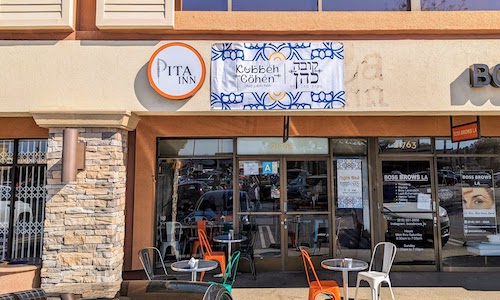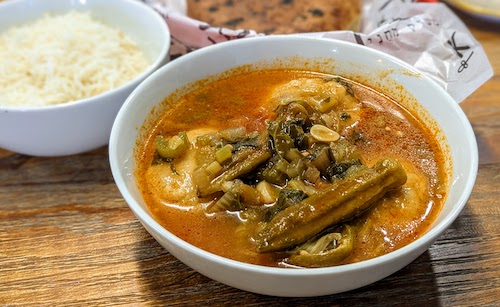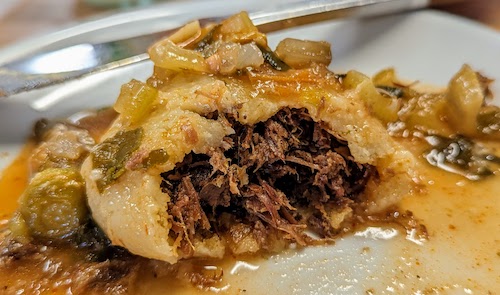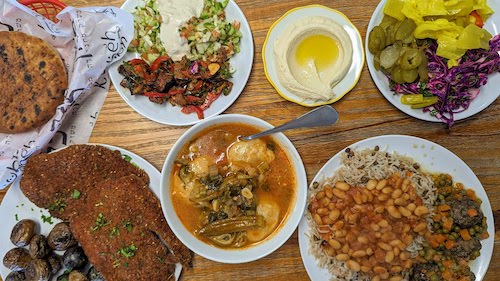🇮🇱 ISRAEL (via Iraq and Kurdistan)
📍 21765 Ventura Blvd., Woodland Hills, San Fernando Valley
🅿️ Ample parking in plaza
🥤 No Alcohol
📍 21765 Ventura Blvd., Woodland Hills, San Fernando Valley
🅿️ Ample parking in plaza
🥤 No Alcohol
The amount of steps involved for a dish like kubbeh to arrive in Los Angeles cannot quite be counted on one hand, and maybe not even on two. The family of dishes known by this name were originally eaten in the homes of Jewish communities in Kurdistan (parts of which are in modern Iraq, Syria, Turkey, and Iran) for hundreds of years. These communities were almost entirely insular, so the dishes did not find a wider audience until these Jewish people left these lands en masse starting in the 1940's and 50's and mostly resettled in Israel.
Versions of kubbeh became very popular throughout the country and are now eaten by all types of Jewish people, not just the estimated 200,000-500,000 descended from Kurdistan who live there today. It is especially popular in the city of Jerusalem, and most travelers that make food the focus of their journeys have probably made their ways to the partially covered Mahane Yehuda Market, where pots of kubbeh soups are simmering in front of some stands to advertise the dish.
The dish and much of the rest of the compact menu at Kubbeh Cohen takes plenty of preparation, but they all set up nicely for this fast casual restaurant. Large pots are displayed like at the market in Jerusalem to help customers make up their minds. A restaurant focusing on the dish first made its way to the United States in New York City in 2017, but this seems to be its starting point in Los Angeles, and it may be the most interesting concept to open since the pandemic.
Along with these pots, you will see the day's side dishes (below) and other daily specials not listed on the menu. With some items only available Friday or during evenings, it makes more sense to just look what is in front of you, take a peek into the pots, and speak with the chef to determine your order. Almost all of the preparation has taken place before opening, so it only takes a couple minutes for food to be ready after paying at the counter.
Depending on what you order, plates of crisp vegetables and pickles,
roasted eggplant, a tahini-smothered chopped salad, and the house hummus will be prepped for the table. Each item is fresh and flavorful, brightening the rest of the meal with sparks whether you dip, spoon, or grab them with your fingers. A simple bowl of rice is the garnish for an order of one of many kubbeh options, which are listed as either Iraqi or Kurdi [Kurdish] versions.
The latter options are known as kubbeh hamusta, which means sour in Kurdish and gets its tone from the use of fresh lemon juice and citric acid in the broth. The Kurdi kubbeh okra siske meat ($23, below) might surprise someone who is not ready for this tartness, as the color of the broth somehow tricks you into expecting a different taste. But after the initial shock it grows on you, the bowl is suddenly empty and you are longing for more.
The shining star and namesake semolina dumpling is somewhat hidden by the broth, okra, and other vegetables when it arrives, but will soon be the focus of your meal. The thick shell is slightly chewy and luxurious and would be laughed at further east in Asia, but combined with the savory shredded beef inside pairs perfectly with the hamusta broth.
They usually have three or four soups daily, including one bright pink version that gets its color from beets, a traditional variety of kubbeh that is much less sour. Staring into this cauldron is almost hypnotic from the color, and this will certainly be the choice on a follow-up visit. The semolina cases of these kubbeh are stained the same color as beets, just like anything else that comes in contact with the root vegetable.
Schnitzel plays a good part at Kubbeh Cohen as well, available daily either in a pita dressed up with salad or on a plate with sides that you can dress on your own. You can also get a Moroccan Jewish-inspired schnitzel sandwich on Fridays that has matbucha jam and comes on challah. The crispy schnitzel plate ($21, below) is indeed crisp, with a nice deep fry on every surface of the chicken. Unfortunately the meat itself is just a bit dry, but this is easily remedied with those plates of greens, pickles, and hummus shown above.
The roasted potatoes that were chosen to pair with this plate and seen below are somewhat of a revelation. They do not look like much, but are tasty, cooked well, and full of fresh herbal flavor. They will be a part of future meals here if they are available. There is also usually a big plate of spaghetti, which seems to have a thin tomato sauce on it and must be popular since it is always an option as a side.
As mentioned earlier, it is also worth asking about what daily specials are available on the day you show up. If you are one of the few customers not speaking Hebrew, all the dishes out on display are great since there is almost no English used at the register. When asking about the pot of meatballs that were front and center on a recent Sunday, "meat" was the only descriptor that could be offered.
They looked tasty enough, and since arayes were not around on this day, an order of meat ($22, below) was placed. Daily specials always are listed at this price, and come with your choice of two sides. Already leaning towards the mujadara and fasulia, the chef pointed towards these first and heads were nodded in approval, as it seemed the two would make a proper combination with the meatballs.
The Hebrew word for meatballs is k'tzitzot, although this can also be used for other types of formed meat like on skewers. You can find many recipes of these online made with beef or chicken and often paired with frozen peas. The vegetables used here do not detract from the delicious beef meatballs though, which are full of onions, garlic, and plenty of herbs, and just about as juicy as can be imagined.
Mujadara is a combination of lentils and rice cooked together, and fasulia in Israel usually takes the form of white beans in a simple tomato stew. Combined together and then with the meatballs, the daily special was indeed special and the plate was thoroughly cleaned. It is also another opportunity to throw in zippy bites of salad and tahini or pickles. Make sure your order also somehow gets a fresh round pita to the table, as these fluffy, inch-thick loaves of bread are just as good as everything else that comes out of the small kitchen.
🇮🇱🇮🇱🇮🇱
I COULD USE YOUR HELP
Eat the World Los Angeles is and always has been free. It is a hobby born of passion and never solicits money or free food from restaurants. No advertisements block the content or pop over what you read. If this website has helped you explore your city and its wonderful cultures a little better please tell your friends about us and if you have the means to contribute, please consider doing so. Eat the World Los Angeles is a labor of love, but also takes a lot of money and time everyday to keep running.Thank you!
VENMO: @JAREDCOHEE
CASH APP: $JaredCohee
PAYPAL: (no account necessary, use link)










No comments:
Post a Comment
Note: only a member of this blog may post a comment.